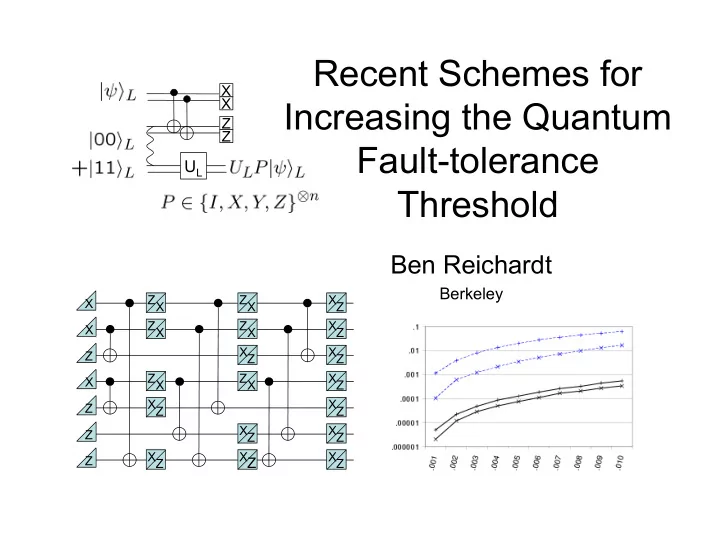

Recent Schemes for X X Increasing the Quantum Z Z Fault-tolerance U L Threshold Ben Reichardt Berkeley Z Z X X X X Z Z Z X X X X Z X X Z Z Z Z Z X X X X Z X X Z Z Z X X Z Z Z X X X Z Z Z Z
Classical fault-tolerance [Von Neumann ‘56] , 0 Perfect op’s: Make fault-tolerant a circuit consisting of a 1 , universal set of operations, some faulty: Faulty op’s: AND, NOT 0 0 L = 0 0 0 1 1 0 0 m m o o n n d d 1 0 0 n o n o a i a i t t 0 r a r a t t u u m m 1 1 1 r r 1 e e 0 p p 1 L = 1 1 Encoding Transverse Error correction gate application 0 1 fraction of 1’s
Continuous quantum states Quantum bit (qubit) Classical bit
Qu disadvantages • Errors inevitable - Continuous quantum states - Tradeoff between controllability and stability • No cloning: local duplication undefined Qu advantage! ? • Can defer exposure of data to operations
Overview [R ‘04] � Postselection Improved threshold result – Modification of standard error correction scheme increases estimated threshold 3x, to almost 1%. � Teleportation Knill’s threshold result – Theorem: Threshold for erasure errors is � for Bell measurements. – Estimated 5-10% threshold for independent depolarizing errors. � Magic states distillation [R ‘04] Universality result – Theorem: Stabilizer operations ? Defer exposure of data to operations plus the ability to prepare any pure state not a stabilizer state gives quantum universality.
Quantum fault-tolerance problem 0 / 1 Larger, fault-tolerant CNOT: 00 00 a a U , , 01 01 a b b 10 10 , 11 11
Discrete errors bit flips: phase flips: Duality:
Quantum codes Classical codewords in the 0/1 basis � Correct bit flip X errors Classical codewords in the +/- basis � Correct phase flip Z errors E.g., quantum [[7,1,3]] code corrects arbitrary error on one qubit � Based on classical Hamming [7,4,3] code
Standard fault-tolerance scheme [Steane,…] Def: CNOT a a X Z a b b Fact 1: Fact 2: X 1-a 1-a X 1-a+b b X X X data ancilla
Threshold from concatenation • N gate circuit 0 . 0 2 5 Want error 1/N • [[7, 1, 3]] code only 0 . 0 2 corrects 1 error Logical gate error rate Probability Physical bits 0 . 0 1 5 of error per logical bit p 1 1/c 0 . 0 1 c p 2 7 ~p 22 7 2 0 . 0 0 5 p 23 7 3 O(log log N) concatenations 0 . 0 0 5 0 . 0 1 0 . 0 1 5 0 . 0 2 0 . 0 2 5 O(log N) physical bits / logical Physical gate error rate
Overview [R ‘04] • Postselection Improved threshold result – Modification of standard error correction scheme increases estimated threshold 3x, to almost 1%. • Teleportation Knill’s threshold result – Theorem: Threshold for erasure errors is � for Bell measurements. – Estimated 5-10% threshold for independent depolarizing errors. • Magic states distillation [R ‘04] Universality result – Theorem: Stabilizer operations ! Defer exposure of data to operations plus the ability to prepare any pure state not a stabilizer state gives quantum universality.
Z Z X X X Z Z Z X X X Z X X Z Z Z Z X X X Z X X Z Z X X Z Z X X X Z Z Z error correction ! ! o o n n t t i i c c t t e e d d e e
Logical ancilla errors Effect of .1 Logical ancilla error rate postselection in .01 Steane Z .001 ancilla preparation Steane X Reject Z .0001 Reject X .00001 [R ‘04] .000001 .001 .002 .003 .004 .005 .006 .007 .008 .009 .010 Physical error rate Time to prepare encoded ancilla Effect on threshold 25 .1 20 .01 Crash rate 15 Steane Steane avg Reject Reject avg 10 3/4 .001 5 0 .0001 0 .001 .002 .003 .004 .005 .006 .007 .008 .009 .010 2 3 4 5 6 7 8 9 0 1 0 0 0 0 0 0 0 0 1 1 0 0 0 0 0 0 0 0 0 0 . . . . . . . . . . Physical error rate Physical error rate
Teleportation : Knill’s erasure threshold of � Teleportation Theorem [Knill ‘03]: Threshold for erasure error is � for Bell measurements. X Z
Teleportation Alice Bob
Teleportation + Computation Alice U Bob Assume no errors!
Teleportation : Knill’s erasure threshold of � Teleportation Theorem [Knill ‘03]: Threshold for erasure error is � for Bell measurements. X Z + Computation + Fault-tolerance X X Z Z U U L [Knill ‘04]: Estimated threshold of 5-10%.
Open questions ? • Errors inevitable in quantum computers • Fault-tolerance schemes can tolerate physically plausible error rates X X Z Z U L [R ‘04] [Knill ‘04] Efficient? Provable?
Recommend
More recommend